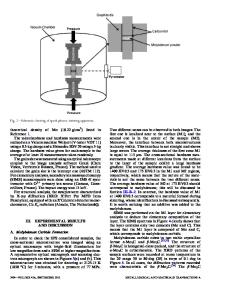Rearrangement densification in liquid-phase sintering
- PDF / 707,693 Bytes
- 7 Pages / 612 x 792 pts (letter) Page_size
- 36 Downloads / 395 Views
I. INTRODUCTION
THREE stages of liquid-phase sintering are encountered after the liquid forms. On liquid formation, there is a burst of rearrangement densification, followed by solution reprecipitation with concomitant grain growth and grain-shape accommodation, with final solid-skeletal densification. If there is a high liquid content, full density can be achieved via rearrangement upon liquid formation. At intermediate liquid contents, the solid-grain packing inhibits densification, requiring the participation of solution-reprecipitation events, where mass transport through the liquids controls grain reshaping. At low-liquid contents, densification is dominated by solid-state sintering of the rigid solid skeleton.[1] In practice, liquid-phase sintering to a high density must occur in a short time. Even though mass transport is very rapid in the presence of a liquid phase, it is not sufficient to ensure rapid densification. Grain rearrangement upon liquid formation is the most important stage if rapid sintering densification is to be attained in practice. A liquid enhances sintering densification due to the interparticle capillary forces. Once a wetting liquid forms it penetrates existing solid-grain boundaries and forms a pendular bond that provides a capillary force on the grain contacts. This capillary force results in a sintering force that causes grain rearrangement, densification, and contact flattening.[2–6] The degree to which the liquid wets the solid grains determines the mode of liquid-phase sintering. If the quantity of liquid is small or the solid grains are not wetted by the liquid, then bonding will be mainly by solid-state diffusion, i.e., conventional sintering. Only when the liquid phase wets the solid grains is the sintering process markedly affected. If the grains are spherical and completely wetted by liquid, then full densification is theoretically possible by grain arrangement, given sufficient liquid phase. Effort has been made to explain and quantify the process JIANXIN LIU, Senior Materials Engineer, is with the Prometal Division, Extrude Hone Corporation, Irwin, PA 15642. RANDALL M. GERMAN, Brush Chair Professor in Materials and Director, is with the Center for Innovative Sintered Products, The Pennsylvania State University, University Park, PA 16802-6809. Manuscript submitted February 6, 2001. METALLURGICAL AND MATERIALS TRANSACTIONS A
of grain rearrangement.[2,7] On liquid formation, grain rearrangement occurs due to the uneven capillary forces exerted by the liquid on the solid grains. Accordingly, the theoretical treatment of grain rearrangement involves consideration of a random network of capillary forces. Huppmann and Riegger[2] investigated the rearrangement process to show instantaneous shrinkage ␦L/L depended on the mean capillary force per contact,
␦L ⫽ k(Fn ⫺ F0) L
[1]
where k is a constant at a given grain size, Fn is the capillary force per contact, and F0 represents an inherent resistance to grain rearrangement. However, this equation did not describe the rearrangemen
Data Loading...











